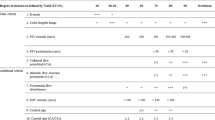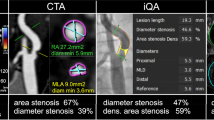Abstract
Doppler/duplex ultrasound (DUS) and computed tomographic angiography (CTA) are frequently applied methods to assess the degree of proximal internal carotid artery (ICA) stenoses in patients with acute ischemic stroke. This study evaluated the agreement and interrater reliability (IR) of both methods using a revised DUS grading system as well as different criteria (ECST/NASCET) under real-life conditions. CTA and DUS data of 281 proximal ICA stenoses [143 patients; 65.7 % male; age (mean (years) ± SD, range) 72.2 ± 11.1, 40–99] were retrospectively analyzed. For both methods, two independent raters estimated the degree of stenosis according to NASCET and ECST criteria. DUS raters applied revised German DUS criteria. For agreement and IR assessment, the linear weighted Kappa statistic was used. Correlation between DUS and CTA was substantial irrespective of the applied classification [weighted Kappa: 0.77 (NASCET)/0.79 (ECST)]. IR for DUS was almost perfect (weighted Kappa: 0.94) and better than for CTA [weighted Kappa: 0.78 (NASCET)/0.78 (ECST)]. In a real-life setting, CTA and DUS assessments of the degree of proximal ICA stenoses agreed substantially irrespective of the criteria applied (ECST/NASCET). For DUS, IR was better than for CTA.
Similar content being viewed by others
References
Hill AB (1998) Should patients be screened for asymptomatic carotid artery stenosis? Can J Surg 41:208–2013
Jacobowitz GR, Rockman CB, Gagne PJ et al (2003) A model for predicting occult carotid artery stenosis: screening is justified in a selected population. J Vasc Surg 38:705–709
Kiechl S, Willeit J, Rungger G, Egger G et al (1994) Quantitative assessment of carotid atherosclerosis in a healthy population. Neuroepidemiology 13:314–317
Willeit J, Kiechl S (1993) Prevalence and risk factors of asymptomatic extracranial carotid artery atherosclerosis. A population-based study. Arterioscler Thromb 13:661–668
Hillen T, Nieczaj R, Munzberg H et al (2000) Carotid atherosclerosis, vascular risk profile and mortality in a population-based sample of functionally healthy elderly subjects: the Berlin ageing study. J Intern Med 247:679–688
Hankey GJ, Warlow CP, Molyneux AJ (1990) Complications of cerebral angiography for patients with mild carotid territory ischaemia being considered for carotid endarterectomy. J Neurol Neuro surg Psychiatry 53:542–548
Wardlaw JM, von Kummer R, Carpenter T (2015) Protocol for the perfusion and angiography imaging sub-study of the Third International Stroke Trial (IST-3) of alteplase treatment within six-hours of acute ischemic stroke. Int J Stroke 10:956–968
Widder B, von Reutern GM, Neuerburg-Heusler D (1986) Morphologic and Doppler sonographic criteria for determining the degree of stenosis of the internal carotid artery. Ultraschall Med 7:70–75
Arning C, Widder B, von Reutern GM et al (2010) Revision of DEGUM ultrasound criteria for grading internal carotid artery stenoses and transfer to NASCET measurement. Ultraschall Med 31:251–257
Carpenter JP, Lexa FJ, Davis JT (1996) Determination of duplex Doppler ultrasound criteria appropriate to the North American Symptomatic Carotid Endarterectomy Trial. Stroke 27:695–699
Oates CP, Naylor AR, Hartshorne T, Charles SM, Fail T, Humphries K, Aslam M, Khodabakhsh P (2009) Joint recommendations for reporting carotid ultrasound investigations in the United Kingdom. Eur J Vasc Endovasc Surg 37:251–261
Landis JR, Koch GG (1977) The measurement of observer agreement for categorical data. Biometrics 33:159–174
Zavanone C, Ragone E, Samson Y (2012) Concordance rates of Doppler ultrasound and CT angiography in the grading of carotid artery stenosis: a systematic literature review. J Neurol 259:1015–1018
von Reutern GM, Goertler MW, Bornstein NM, Del Sette M, Evans DH, Hetzel A, Kaps M, Perren F, Razumovky A, von Reutern M, Shiogai T, Titianova E, Traubner P, Venketasubramanian N, Wong LK, Yasaka M, Neurosonology Research Group of the World Federation of Neurology (2012) Grading carotid stenosis using ultrasonic methods. Stroke 43:916–921
Alexandrov AV, Bladin CF, Maggisano R, Norris JW (1993) Measuring carotid stenosis. Time for a reappraisal. Stroke 24:1292–1296
de Bray JM, Glatt B (1995) Quantification of atheromatous stenosis in the extracranial internal carotid artery. Cerebrovasc Dis 5:414–426
Acknowledgments
Prof. M. Wiesmann reports grants and personal fees from Stryker Neurovascular, grants and personal fees from SilkRoad Medical, grants from Covidien, grants from Microvention, grants and personal fees from Bracco, grants and personal fees from Siemens, grants from AB Medica, grants from Acandis, grants from Codman Neurovascular, grants from Penumbra, grants from Phenox, grants from Abbott, grants from St. Jude, from B. Braun, outside the submitted work.
Author information
Authors and Affiliations
Corresponding author
Ethics declarations
Conflicts of interest
All other authors declare no conflict of interest.
Ethical approval
Our study has been approved by the local ethics commission.
Informed consent
For this type of study formal consent is not required.
Rights and permissions
About this article
Cite this article
Matz, O., Nikoubashman, O., Rajkumar, P. et al. Grading of proximal internal carotid artery (ICA) stenosis by Doppler/duplex ultrasound (DUS) and computed tomographic angiography (CTA): correlation and interrater reliability in real-life practice. Acta Neurol Belg 117, 183–188 (2017). https://doi.org/10.1007/s13760-016-0676-4
Received:
Accepted:
Published:
Issue Date:
DOI: https://doi.org/10.1007/s13760-016-0676-4




